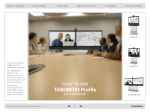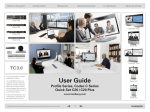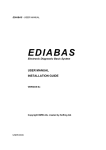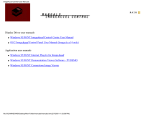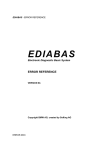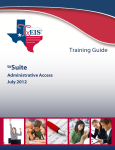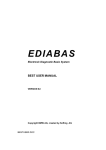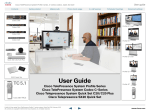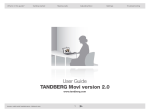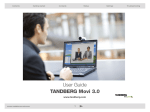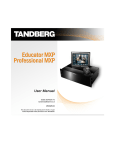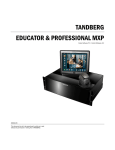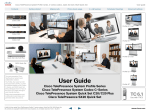Download TANDBERG C90 User's Manual
Transcript
What’s in this guide? Getting started Making calls Using the phone book User Guide TANDBERG Codec C90 www.tandberg.com D14306.01 USER GUIDE TANDBERG CODEC C90—NOVEMBER 2008 1 In-call features Video conferencing What’s guide? What’s in in this this guide? Getting started Making calls Using the phone book In-call features Video conferencing What’s in this user guide? Getting started Quick search by letters................................. 17 Adding new contacts to the phone book......... 18 Adding an entry from recent calls or the phone book....................................... 18 Adding an entry manually to My contacts..... 18 Editing existing entries in the phone book....... 19 Editing entries in the phone book................. 19 Waking up the system....................................... 4 The TRC5 remote control.................................. 5 Navigating in the menus.................................... 7 If there is no menu shown............................... 7 Entering text in text fields.................................. 8 What happens when you press a number key?............................................... 8 Using the number keys in text fields............... 8 Special characters......................................... 8 Screen layout options for single screen............. 9 Adding wallpaper to your screen.................... 9 Screen layout options for dual screen............. 10 In-call features BestView—Face recognition............................ 21 Using Best view........................................... 21 Where to find it............................................. 21 Running a presentation................................... 22 Making calls Video conferencing Making calls by dialing the number................. 12 When someone is calling................................ 12 Terminating an ongoing call............................. 12 Making calls using phone book....................... 13 Making calls using the recent calls list............. 14 The icons used............................................ 14 About video conferencing............................... 24 Who becomes the host?.............................. 24 Calling more than one..................................... 25 Example....................................................... 25 Phone book usage Basic phone book features............................. 16 Navigating in the phone book....................... 16 Calling an entry in the phone book............... 16 Opening the phone book:............................ 16 Searching in the phone book.......................... 17 Entering text in the search field.................... 17 D14306.01 USER GUIDE TANDBERG CODEC C90—NOVEMBER 2008 2 What’s in this guide? Getting started Getting started Making calls Using the phone book Chapter 1 Getting started D14306.01 USER GUIDE TANDBERG CODEC C90—NOVEMBER 2008 3 In-call features Video conferencing What’s in this guide? Getting started Getting started Making calls Using the phone book Waking up the system In-call features Video conferencing After wake-up, the screen will typically look like this: To make a call you need to wake up the system from standby. However, if someone calls you, the system will wake up by itself. The IP number of your system is the dial-in number of your system. • To wake up the system just pick up the remote control or press any key. You may have to point the remote control towards the system to make it discover you. Date and time of day. [email protected] • The system will now show the welcome screen, which contains the main menu and it will display the main camera image in the background. • The IP number (whenever applicable) and the system name are displayed in the upper left corner. • The IP number is the dial-in number of your system. • The screen will also indicate if there are any calls you have missed. Softkeys (described on the following pages). Should the system fail to respond to the remote control or to incoming calls, make sure that: • The system is connected to line voltage • The remote control has working batteries • The internal cables, such as the monitor cable and/or the camera cables are properly connected, cf. the installation sheet. D14306.01 USER GUIDE TANDBERG CODEC C90—NOVEMBER 2008 4 What’s in this guide? Getting started Getting started Making calls Using the phone book In-call features Video conferencing The TRC5 remote control The function keys in the upper part of the remote control reflects the softkeys on screen... ... and the middle part of the remote control is used to handle the video part of the call ... while the lower part of the remote control resembles very much the keypad of a cell phone. FUNCTION KEYS: Each key reflects a soft key on screen and represents shortcuts and advanced functions. MICROPHONE: Press the key to toggle the microphones on/off. VOLUME: Press the + or – on the key to adjust the volume. PRESENTATION: key Press the to show/hide a presentation. ARROW UP/DOWN: Use the and arrow keys to navigate in the menu and to move the camera (pan, tilt) when the menu on screen is not displayed. ARROW LEFT: Press the arrow key to go one step back in the menu or to move to the left in a text field. ZOOM: Press the + or – on the key to zoom the camera in and out. OK/SELECT: Press the D14306.01 USER GUIDE TANDBERG CODEC C90—NOVEMBER 2008 5 ARROW RIGHT: Press the arrow key to expand the selected menu item or to move to the right in a text field. key to confirm your choice or selection. What’s in this guide? Getting started Getting started PHONE BOOK: Press key to display the the phone book. Making calls Using the phone book 0-9, a-z, period (.), @, space, *: Press a key repeatedly to toggle between the options displayed on each key. HOME: Press key to go the back to the Home menu. abc/123 #: Press the # key to toggle between lower case characters and numbers. END CALL / STANDBY: key Press the to end a call or—when idle—to go into standby mode. CLEAR: Press the key to remove characters in a text field. D14306.01 USER GUIDE TANDBERG CODEC C90—NOVEMBER 2008 Video conferencing Alphanumeric keypad: Use the keypad in the same way as you would use a cell phone. LAYOUT: Press the key to display the Layout menu, then select a view in the menu. CALL: Press the key to display the Recent Calls menu. Select one or more contacts and press the key to initiate the call. In-call features 6 What’s in this guide? Getting started Getting started Making calls Using the phone book Navigating in the menus In-call features Video conferencing Example showing a submenu produced by pressing the right arrow key. Your TANDBERG Codec C90 is operated by means of the remote control. All you need to know to get started are a few basic navigation principles. The little triangle indicates that there are further submenus available. Use the right arrow key or to show this submenu. • Press the home key ( ) to show the home menu. • The arrow keys in the center of the upper part of the remote control are used to navigate in the menus. • When the system shows the home menu only, pressing home key ( ) will hide the menu. To bring it back, press the home key ( ) again. • In an input field pressing cancel will delete characters/numbers to the left of the cursor position. Use the left arrow key to collapse the menu expansion, i.e. to go back one level. Use the home key ( ) to exit all menus and return to showing the home menu only. Press the key to produce the home menu on the screen. The element currently selected is indicated by an orange rectangle. Use the vertical arrow keys to navigate up and down in a menu. The little triangle indicates that a submenu is available. Context sensitive softkeys corresponding to the function keys of the remote control. If there is no menu shown... Wake up the system by lifting the remote control and press the produce the home menu. D14306.01 USER GUIDE TANDBERG CODEC C90—NOVEMBER 2008 key to 7 Softkeys not used in a given context are shown ghosted. What’s in this guide? Getting started Getting started Making calls Using the phone book Entering text in text fields In-call features Using the number keys in text fields Some menu fields expect text information to be entered. Apart from the need to enter the number or identity of the person you want to call, you will also—among other things—need this ability to search and maintain your list of contacts in the phone book. Whenever text entries are expected by the system, a small abc or ABC appears in the right lower corner of the entry field. For entry fields expecting numbers, 123 will appear instead. In text mode, entries from the number keys are automatically interpreted as text entries in the same way as on a cell phone. What happens when you press a number key? Guidelines: • Press the key that corresponds to the required letter as many times as needed to produce that letter • Switch between lower case (abc) and upper case (ABC) letters with the # a/A key • Switch between text mode (abc) and number mode (123) by keeping the # abc/123 key depressed for more than a second • To insert space, press the 0 _ key • To insert the @ sign, press the 1-key twice, while the keypad is in text mode • To insert the . sign, press the .-key once, while the keypad is in * number mode • To write digits and numbers in a text input field, repeatedly press the corresponding key until the digit appears. • Pressing a number key outside calls will cause the call menu to be shown. • When the cursor is positioned inside an entry field expecting text entries, the system automatically switches to text mode (ABC). Entering letters is similar to as on a cell phone—see right. • When the cursor is positioned inside an entry field requiring number entries, the system automatically switches to number mode (123) allowing numbers to be dialed with the number keys as usual. Special characters Sometimes you will need to make use of special characters, e.g. when entering names in My contacts. Whenever it is likely that special characters are needed, a softkey (see the left Fig.) giving you access to the special characters menu will be displayed. Special characters D14306.01 USER GUIDE TANDBERG CODEC C90—NOVEMBER 2008 Video conferencing 8 What’s in this guide? Getting started Getting started Making calls Using the phone book Screen layout options for single screen In-call features Video conferencing Layout control outside a call is limited to the choice between showing selfview and showing a wallpaper... The layout of the screen for single screen configurations can be changed as shown here. • To produce display options screen, press the layout ( ) key • Use the arrow keys to move between the alternatives and use to select the alternative you want to use • Note that you may, or may not, include selfview (i.e. the outgoing video signal from your own system) • You set whether to include selfview or not by means of the left-most softkey. Adding wallpaper to your screen In the home menu, navigate down to Settings and press the key. In the settings submenu navigate down to Wallpaper. Press again. Layout control used during a call gives you more possibilities... Select between the options available and press the key to leave the menu putting your choice into effect. D14306.01 USER GUIDE TANDBERG CODEC C90—NOVEMBER 2008 9 What’s in this guide? Getting started Getting started Making calls Using the phone book Screen layout options for dual screen Video conferencing Layout control used during a call will depend on how many participants there are in the call. Note that the use of external infrastructure equipment may open up for calls with many participants. The layout of these calls may be controlled by the external equipment itself. The layout of the screen for dual screen configurations can be changed as shown here. • To produce display options screen, press the layout ( ) key • Use the arrow keys to move between the alternatives and use to select the alternative you want to use • Note that you may, or may not, include selfview (i.e. the outgoing video signal from your own system) • You set whether to include selfview or not by means of the left-most softkey. • To set up for showing wallpaper is described on the previous page. A dual screen point-to–point call. The option selected in this example will be useful if a presentation is added to the call. A dual screen call involving three participants in total. Layout control outside a call is limited to the choice between showing selfview and showing a wallpaper, but in a slightly different manner compared to single screen configurations. Note that if you choose Hide selfview, the double screen without wallpaper will look grey A dual screen call involving four participants in total. D14306.01 USER GUIDE TANDBERG CODEC C90—NOVEMBER 2008 In-call features 10 What’s in this guide? Getting started Making calls Making calls Using the phone book Chapter 2 Making calls D14306.01 USER GUIDE TANDBERG CODEC C90—NOVEMBER 2008 11 In-call features Video conferencing What’s in this guide? Getting started Making calls Making calls Using the phone book In-call features Making calls by dialing the number When someone is calling Observe that the term “number” has a wide definition here; you may use the procedure outlined on this page to call people by their alphanumeric address as well, for example: Respond to an incoming call by pressing the accept it, or press the key to reject it. Video conferencing key on the remote control to “[email protected]” Press the key to produce the call menu, if needed. Position the cursor at Call and press to produce the submenu. Press the key on the remote control to reject an incoming call Press the key on the remote control to answer an incoming call Terminating an ongoing call Terminating an ongoing call is similar to terminating calls on a cell phone— just press the key on the remote control. Key in the “number” to call. If needed, switch to alphanumeric setting by means of the abc/123/ABC softkey. Press the softkey Special characters to access non-standard characters, if needed. See Special characters on page 8 for more on this. Press to start calling. D14306.01 USER GUIDE TANDBERG CODEC C90—NOVEMBER 2008 Press the key on the remote control to terminate an ongoing call 12 What’s in this guide? Getting started Making calls Making calls Using the phone book Making calls using phone book Method 2: Making use of the phone book is time saving and prevents you from inadvertently calling the wrong number. Press the key to produce the call menu, if needed. Position the cursor at Call and press to produce the submenu… The entries, often referred to as contacts, are sorted alphabetically. Method 1: Press the Phone book key… In-call features ...then navigate down to Phone book and press to display the phone book. … to show the phone book. If you know your way, navigate down to the folder required and press to produce the contents of that folder. Use the arrow keys to locate whom to call and press to place the call. If you know your way, navigate down to the folder required and press to produce the contents of that folder. Use the arrow keys to locate whom to call and press to place the call. Alternatively, you may search for an entry in the phone book. This is described in the section Phone book usage. Alternatively, you may search for an entry in the phone book. This is described in the section Phone book usage. D14306.01 USER GUIDE TANDBERG CODEC C90—NOVEMBER 2008 13 Video conferencing What’s in this guide? Getting started Making calls Making calls Using the phone book In-call features Video conferencing Making calls using the recent calls list If you have called somebody, or somebody has called you, this will be listed in the list of recent calls. To gain access to the recent calls list, just press the control. key on the remote You may also copy entries in the recent calls list to your phone book—see Using the phone book for details. The icons used The icon is used to denote calls made by you. The icon is used to denote calls received. The icon is used to denote missed calls. D14306.01 USER GUIDE TANDBERG CODEC C90—NOVEMBER 2008 Select what type of recent calls to show; All recent calls, just the missed calls, just the placed calls or just the received calls, by means of the softkeys. 14 What’s in this guide? Getting started Making calls Using book Using the the phone phone book Chapter 3 Phone book usage D14306.01 USER GUIDE TANDBERG CODEC C90—NOVEMBER 2008 15 In-call features Video conferencing What’s in this guide? Getting started Making calls Using book Using the the phone phone book Basic phone book features In-call features Video conferencing Opening the phone book: Your TANDBERG Codec C90 contains a phone book functionality, which is very similar to what you find in a mobile phone. It contains a section in which you can add your own list of contacts, and most corporate solutions will also include a corporate phone list. This latter list is normally installed and maintained from remote by your system administrator through a management system like the TANDBERG Management Suite (TMS), which is available separately. Press the phone book key… You cannot edit the corporate list yourself, but you may add entries to My Contacts. These may be edited ad libitum. Navigating in the phone book • Basic navigation in the phone book is done in the usual way. • When positioned at a line with a small folder icon in front, press the right arrow key to produce the contents of this folder. Repeat, if needed, if there are more levels. • Whenever you are at a lower level, use the left arrow key to move one level back. This will cause the phone book menu to open… Calling an entry in the phone book Once an entry is located, just press the key to place the call. The phone book typically contains your own My contacts and a corporate phone book. In My contacts you may enter your own contacts. Need to search for an entry in the phone book? See Searching in the phone book on the next page. D14306.01 USER GUIDE TANDBERG CODEC C90—NOVEMBER 2008 16 What’s in this guide? Getting started Making calls Using book Using the the phone phone book Searching in the phone book In-call features Video conferencing Quick search by letters To search for an entry in the phone book, navigate to where you assume the entry resides. Any search will be done within the folder your cursor at present is located and inside any subfolders within this folder. While the My contacts may contain up to 200 entries, the entire phone book (which may include server based corporate directories) can be virtually unlimited in size. Consequently, using the arrow keys as the only navigation device can easily become a cumbersome task. What to do? If in doubt, remain at the top level (called root in computer terminology) and do your search from there. Enter Quick Search by Letters. Whenever you are inside the phone book navigating in the list of entries, the numerical keypad automatically switches from 123 mode to ABC mode. To locate a specific entry, just type in the first letter as with a cell phone. The system will then display all matches. Add more letters to refine your search. The search will be done within the folder your cursor at present is located and inside any subfolders within this folder. Just type the letter (or switch to 123 mode by pressing the # key to key in digits) and the Search field will be activated immediately. The phone book will then look something like this: Entering text in the search field Example: How do I write Alice 123 in the Search input field in the phone book? The search will begin immediately. Add more letters to narrow and refine your search. Do as follows: 1. 2. 3. 4. 5. 6. 7. 8. 9. 10. Press the 2-key once to get an A Press the #-key once to switch between upper and lower case letters Press the 5-key three times to get an l Press the 4-key three times to get an i Press the 2-key three times to get a c Press the 3-key twice to get an e Press the 0-key once to get space Press the 1-key three times to get a 1 Press the 2-key four times to get a 2 Press the 3-key four times to get a 3. D14306.01 USER GUIDE TANDBERG CODEC C90—NOVEMBER 2008 Example: Keying in da, will return entries like Dave Olson and David Jones, but also John Dahl and Vittorio Dalmazzino. There is no case sensitivity here. How to open the phone book is described Basic phone book features, which can be found on the previous page. 17 What’s in this guide? Getting started Making calls Using book Using the the phone phone book Adding new contacts to the phone book In-call features Video conferencing Adding an entry manually to My contacts: Open the phone book by pressing the New contacts can be added to My contacts only. Other entries must be entered by you system administrator. key on the remote control. Navigate to My contacts: Press the key to show the contents of My contacts. A softkey named New contact will now appear along the bottom line of the display: Adding an entry from recent calls or the phone book While you are inside the phone book or the list of recent calls, navigate to the entry you would like to copy to My contacts and press the key or the right arrow key to show the options menu: Press the corresponding function key on the remote control to enter the Edit dialog box. Navigate down to Copy to my contacts and press the key to open the dialog box. This is similar to when entering a new contact manually (see right for details), but in this case the name and “number” of the copied contact has been filled in already by the system. If you want to edit the information entered you may do so. Remember to save before leaving the menu. edit Enter name and “number” of the new contact. After you have entered this information, the Save field will no longer appear ghosted and you may navigate down to this field and press the key to save your new entry. Alternatively, navigate down to Cancel and press the dialog box without saving the new entry. How to open the phone book is described Basic phone book features, which can be found two pages back. D14306.01 USER GUIDE TANDBERG CODEC C90—NOVEMBER 2008 18 key to exit the What’s in this guide? Getting started Making calls Using book Using the the phone phone book Editing existing entries in the phone book In-call features Video conferencing Editing entries in the phone book Open the phone book. Since only entries in My contacts may be subject to editing, navigate to My contacts and press the key to open it. You may edit and delete entries in My contacts any time. Since updates in the corporate phone book(s) made by your system administrator will not affect My contacts, you may have to use this feature from time to time when corporate phone book changes are made. Navigate to the entry to edit and press the key again. In the submenu that now appears, navigate to Edit and press the key to open for editing of the entry. You will now see a dialog box similar to this: in which the name and “number” of the entry selected for editing has already been inserted. Edit as required and navigate down to Save and press the changes into effect. D14306.01 USER GUIDE TANDBERG CODEC C90—NOVEMBER 2008 19 key to put the What’s in this guide? Getting started Making calls Using the phone book Chapter 4 In-call features D14306.01 USER GUIDE TANDBERG CODEC C90—NOVEMBER 2008 20 In-call In-call features features Video Videoconferencing conferencing What’s in this guide? Getting started Making calls Using the phone book BestView—Face recognition In-call In-call features features Video Videoconferencing conferencing Where to find it: The TANDBERG Codec C90 is capable of doing face recognition. The face recognition system aims to search for faces in order to optimize the picture frame, and is therefore called BestView. Once a face or group of faces has been detected, camera zoom and camera angle will be changed accordingly in order to obtain an optimal representation on the screen. Kindly observe the following: The Best view feature is still a preview feature. The Best view optimization process may take up to 5 seconds. The detection of faces works better when people look towards the camera. The area from the eyebrows down to just below the lips should be uncovered. • Beard is normally not a problem. • • • • Best view (beta) The Best view feature is found in the Camera control menu Using Best view 1.Press the key on the remote control to display the Layout menu. Select Selfview to be shown as required key on the remote control to display the Home menu and 2.Press the select Camera control 3.In the Camera control menu, locate the Best view button at the bottom of the screen 4.Press the corresponding Function key on the remote control to start the Best view optimization process. Look towards the camera for about five seconds 5.The system will now look for faces and adjust the zoom and camera angle to obtain a best fit. D14306.01 USER GUIDE TANDBERG CODEC C90—NOVEMBER 2008 21 Exit Use this softkey to exit Best view What’s in this guide? Getting started Making calls Using the phone book Running a presentation In-call In-call features features Videoconferencing conferencing Video Do as follows: The presentation functionality in the system enables you to show other available video sources in addition to your main camera. Connect your presentation source(s) to the I/O panel on the codec. This is perfect for meetings where you would like to share a PowerPoint presentation, for example. After you have connected your presentation source you may have to configure your source to make it supply a signal to your video system. The ability to do such presentations requires the optional Natural Presenter Package. If in doubt consult your administrator. Press the Presentation mode key on the remote control. To specify which source to serve for the presentation select it as shown here. Note that the name of each source can be changed, consult your administrator for details on this. D14306.01 USER GUIDE TANDBERG CODEC C90—NOVEMBER 2008 22 What’s in this guide? Getting started Making calls Using the phone book Chapter 5 Video conferencing D14306.01 USER GUIDE TANDBERG CODEC C90—NOVEMBER 2008 23 In-call features Video Video conferencing conferencing What’s in this guide? Getting started Making calls Using the phone book In-call features About video conferencing A video call involving more than two participants is called a video conference or a MultiSite call. You will then make use of the optional built-in MultiSite functionality of your TANDBERG Codec C90. Observe that the infrastructure of your video network may contain external Multi Conference Units (MCU). These are devices dedicated to handle several simultaneous video conferences, each with many participants. Consult your system administrator for information on how to utilize external MCUs, if applicable. Who becomes the host? The host of a video conference is the endpoint to which all the others are connected. In other words, the one who initiated the conference. If two systems both supporting MultiSite have established their own video conference independent of the other and one of these two call the other, cascading will take place. This means that you may have more participants in total than a single system supports. In this case, the host will be the one calling the other. The host has the right to terminate the connection to any of the participants. The participants cannot control any of the others, but may disconnect themselves from the meeting at all times. If you are the one who initiated the video conference, you are considered to be the host by the system. D14306.01 USER GUIDE TANDBERG CODEC C90—NOVEMBER 2008 24 Video Video conferencing conferencing What’s in this guide? Getting started Making calls Using the phone book In-call features Video Video conferencing conferencing Calling more than one Example: Any point-to–point video call (i.e. a call involving two parties only) may be expanded to include additional participants. The call is then becoming a video conference. The below screenshot shows two entries made before any calls are placed. For units equipped with multisite capabilities, up to 3 participants can be called simultaneously if no external MCUs are used. Any ongoing video call can be expanded into a video conference by adding more participants at any moment. Alternatively, you may set up a list of whom to call before you actually call them and then call them all in one go. After you have entered the participants, press the the calls. key to place the Any of these may, of course, be fetched from the phone book in the usual manner. D14306.01 USER GUIDE TANDBERG CODEC C90—NOVEMBER 2008 25 U.S. HEADQUARTERS TANDBERG 1212 Avenue of the Americas 24th Floor New York, NY 10036 Telephone: +1 212 692 6500 Fax: +1 212 692 6501 Video: +1 212 692 6535 E-mail: [email protected] EUROPEAN HEADQUARTERS TANDBERG Philip Pedersens vei 20 1366 Lysaker Norway Telephone: +47 67 125 125 Fax: +47 67 125 234 Video: +47 67 126 126 E-mail: [email protected] Copyright © TANDBERG 2008. All rights reserved. INTELLECTUAL PROPERTY RIGHTS The TANDBERG C90 codec covered by this User Guide is protected under copyright, patent, and other intellectual property rights of various jurisdictions. Any applicable software licenses and any limited warranty are located in the License Information section of the corresponding version of the TANDBERG Administrator Guide for this product.


























